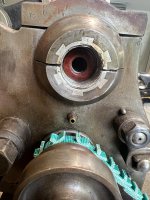I just acquired what seems to be a 12" F E Reed lathe that is in good condition with lots of accessories, power cross feed, taper attachment, 3 & 4 jaw chucks, 12" face plate, what appears to be a full set of threading gears, steady rest, assortment of lathe dogs, live and dead centers, etc. The latest patent date next to the serial number (1042) is 1896 and it has the belt driven carriage. I believe this means it was made between 1896 and 1907. The old catalog I found suggests that the power cross feed was only available on the 14" and larger but it must have been an option on the 12. There is only about 12" between the center line and the ways.
I have a few initial questions.
- It came with a new 1 HP, 3 phase motor which seems to be severely under sized for this lathe. The Babbitt caps were completely loose, with 5-10 thousandths vertical play in the spindle/chuck. When I tightened it just a bit to remove the play, I started getting over-current errors on the motor controller. One question is what would be a reasonable sized motor for this lathe? I don't need anything crazy, just enough power to use it without headaches. I will also have to change the current drive belt, which is like a big rubber band. Trying to take even a moderate cut causes it to stretch and slip. I found the Al Bino belts that look like a good option.
- This is my first experience with Babbitt bearings but If I understand it correctly, there seems to be plenty of room left. The block under the bearing cap is 0.075" above the casting. I believe that the correct procedure is to ship the gap to give near zero vertical play in the chuck with the cap tightened. Picture 4
- On the left side of the headstock there is a large threaded sleeve with a hard rubber/plastic washer between it and the main shaft. I assume this is to control end play and was wondering how to adjust this? Picture 5
Would love to find out as much as possible about this. I am sure I will have other questions. Should I start new threads as they come up or just keep this one running.
Thanks in advance
Mike Hayes
I have a few initial questions.
- It came with a new 1 HP, 3 phase motor which seems to be severely under sized for this lathe. The Babbitt caps were completely loose, with 5-10 thousandths vertical play in the spindle/chuck. When I tightened it just a bit to remove the play, I started getting over-current errors on the motor controller. One question is what would be a reasonable sized motor for this lathe? I don't need anything crazy, just enough power to use it without headaches. I will also have to change the current drive belt, which is like a big rubber band. Trying to take even a moderate cut causes it to stretch and slip. I found the Al Bino belts that look like a good option.
- This is my first experience with Babbitt bearings but If I understand it correctly, there seems to be plenty of room left. The block under the bearing cap is 0.075" above the casting. I believe that the correct procedure is to ship the gap to give near zero vertical play in the chuck with the cap tightened. Picture 4
- On the left side of the headstock there is a large threaded sleeve with a hard rubber/plastic washer between it and the main shaft. I assume this is to control end play and was wondering how to adjust this? Picture 5
Would love to find out as much as possible about this. I am sure I will have other questions. Should I start new threads as they come up or just keep this one running.
Thanks in advance
Mike Hayes









